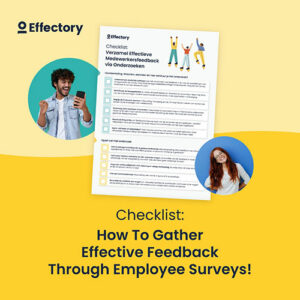As we close the door on one year and look forward to the next, the time to define your intentions for the New Year is here. If driving or maintaining high levels of employee engagement is one of them, we want to help you prepare by looking to the trends for the coming year. Throughout 2016, we worked with over 600 companies to provide them with direct employee feedback solutions, relating feedback directly to measuring employee engagement. Based on that experience, here are seven employee feedback and engagement trends to look for in 2017.
7 employee feedback trends to look out for in 2017

1. Being a sustainably successful company
Becoming a sustainably successful employer means looking beyond shareholders pockets, working to directly contribute to social initiatives, and maintaining a drive to become an employer of choice. Having success on a sustainable level happens when there is a balance between the individual needs of the employee, the requirements of the organisation, and the demands of the external market. Having these three factors in balance is the ideal, however getting there isn’t something that can be attained overnight. HR departments will be focusing on developing the individual needs of employees, pairing them with organisational requirements, and anticipating the demands of talent in their industry. Temporary focus can be put on one or the other factors, but as a long term strategy, the needs of all three factors should be in balance in order to reach this form of sustainability.
2. Self-initiatives for outward development
There is an intentional shift towards hiring talent with higher university degrees, and allowing talent to benefit from professional development in order to expand on role flexibility and freedom. In the past, growth within a role would follow a bottom-up trajectory, where educated graduates would enter the market in junior level jobs, and work and develop themselves with a purely functional focus. Growth would come with promotions, and moving up the proverbial ladder of the organisation. However, not every employee strives to be a manager. After all, only 1 in 10 individuals has the innate ability to manage people. We see a new sense of backing out of roles or organisations that constrain talent’s outward development, and push for upward (managerial) promotion. Outward growth, is when employees act on professional development opportunities, and is attained when an employee has the freedom to set their own professional focus, within their role framework. This is a direct contributor to engagement and it drives innovation. Companies that follow this principle, often reach a higher level of change flexibility and innovation.
3. Autonomous peer feedback
Another factor pertaining to the agility of feedback is providing individual employees with a level of autonomous feedback initiatives. Feedback given on an individual basis between peers, is often associated with a negative connotation, rather than constructive tips for improvement. However, continuous feedback is quickly being accessed as a conduit for improvement, and is key in expediting the learning curve between peers. Autonomous feedback gathering, allows for more frequent one-on-one quality feedback between colleagues, and helps to enable a practice of open culture and communication, and constructive feedback.
How to gather feedback from your employees
The definitive checklist for creating your employee engagement survey.
Download4. Team dynamics that work
Teams are looking for quick and dirty ways to monitor and improve themselves in becoming high performance teams. Team dynamics checks have a potential for gathering relevant feedback, and is directly related to team performance and energy. The pressure on teams to consistently out-perform themselves, can be taxing. We’ve seen a desire for project teams throughout organisational levels, to have a degree of de-centralization when it comes to performing team dynamics checks, by their own initiative and on their own time. By addressing the outcomes of the dynamic checks themselves, teams remove the need to involve HR departments directly in the process itself.
5. Expecting change and learning how to face it
HR managers are looking to get insight into their workforces’ willingness to adapt to change. Change can be very susceptible to internal resistance, and change also has a direct influence on cooperation. Adaptability is the illusive construct that we all want to achieve for our workforce. With the volatility of markets and business environmental changes, uncertainty is not only felt on the top levels of the organisation, but importantly, the willingness to adapt to change is held within the workforce itself.
6. Pulse measuring: listening to feedback faster and easier
HR departments are looking to gather employee feedback on a more regular, less strenuous basis than before. With an emphasis on the frequency with which information is gathered and shared, HR managers want quicker results from engagement surveys, produced more easily, and with fewer entry barriers. This is important as bottom up feedback is quickly gathered and follow up actions can be rolled out faster.
7. Becoming an employer of choice
At Effectory, we define an employer of choice as having a best in class ability to attract and maintain talent, and one who doesn’t hide behind employer branding to provide a mere perception of talent attractiveness. As an employer of choice, your best recruiters are your own people. There’s a war for talent going on. Standing out as an employer in a saturated market is key. HR departments want to retain the talent they have, and attract new talent to their workforce. To facilitate this, they’re utilizing tools to gather employee feedback throughout an employee’s life-time at a company. For instance, entrance and exit surveys, intention to leave measurements, and engagement surveys all contribute to gaining insights as to why talent joins a company, or feels the need to leave their roles.
These are the seven trends that we’re anticipating for 2017, but we’re always curious to know your perspective. Let us know your thoughts, and what you foresee on engagement in your industry regarding employee feedback, talent’s requirements, and organisational trends.
